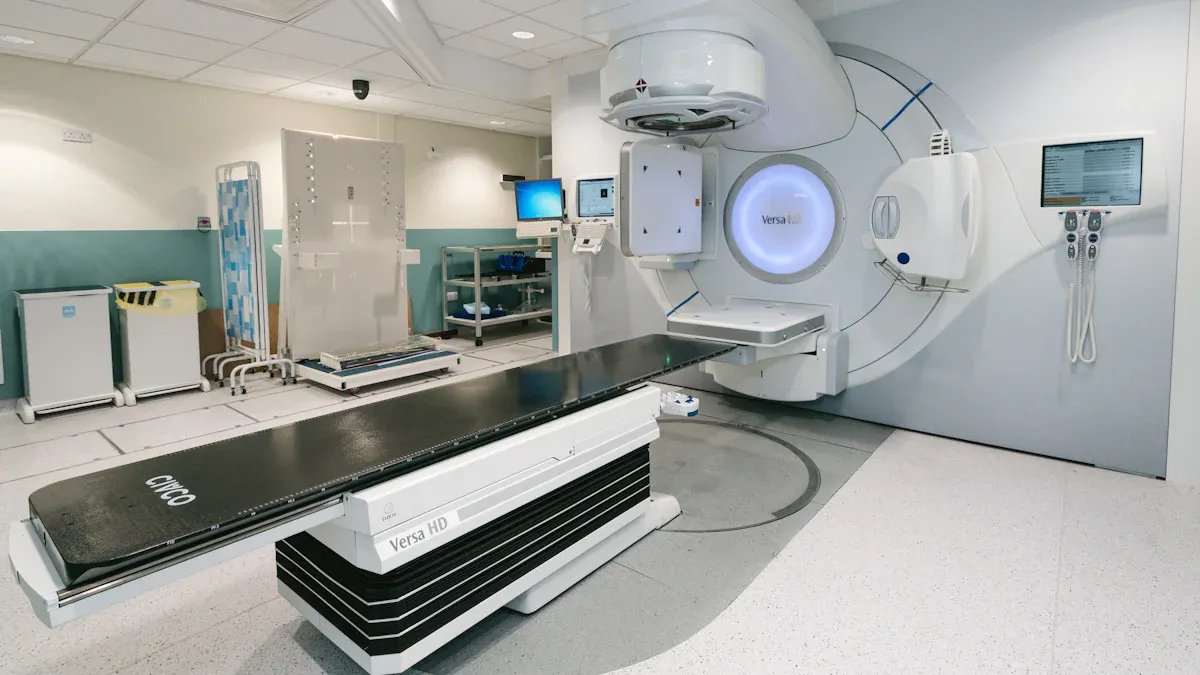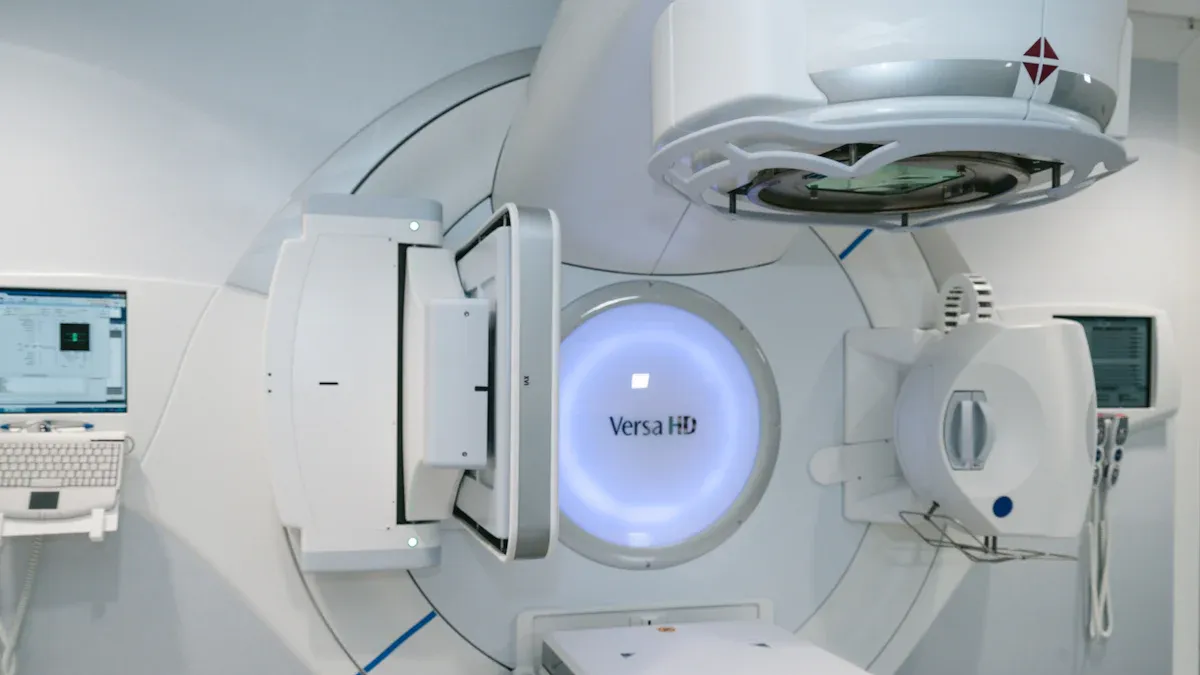Understanding the Science Behind Tumor Treating Fields Therapy

Tumor Treating Fields therapy offers a groundbreaking way to fight cancer. This non-invasive treatment uses alternating electric fields to stop cancer cells from dividing. You benefit from its targeted approach, which focuses on cancer cells while sparing healthy tissue. The therapy has already gained FDA approval for glioblastoma, a challenging brain cancer. Researchers are now exploring its potential to treat other types of cancer, giving hope to many patients.
Key Takeaways
Tumor Treating Fields therapy uses electric fields to stop cancer cells from dividing. It harms cancer cells but leaves healthy cells safe.
This treatment does not require surgery and is approved by the FDA for glioblastoma. It may help with other cancers and works better with regular treatments.
The Optune System sends Tumor Treating Fields straight to the tumor. Patients can still do normal activities while getting treated.
Scientists are studying how Tumor Treating Fields can help with different cancers. It seems useful when combined with chemotherapy or immunotherapy.
Work is being done to make the device easier to use and cheaper. This will help more patients get this therapy.
The Science Behind Tumor Treating Fields

What Are Tumor Treating Fields?
Tumor Treating Fields are low-intensity, alternating electric fields designed to disrupt cancer cell division. This innovative therapy targets cancer cells without harming healthy tissue. You might wonder how this works. Cancer cells divide rapidly, unlike most healthy cells. Tumor Treating Fields exploit this difference by interfering with the process of cell division, making it harder for cancer cells to grow and spread.
Mechanism of Action
How Alternating Electric Fields Disrupt Cell Division
Tumor Treating Fields disrupt cancer cell division by targeting specific stages of the cell cycle. During mitosis, cells rely on structures like the mitotic spindle to divide properly. Tumor Treating Fields impair the formation of these spindles, preventing chromosomes from separating correctly. They also induce dielectrophoretic effects during telophase, which disrupt the movement of polar molecules. These disruptions lead to cell cycle arrest and, ultimately, cell death.
Key mechanisms include:
Impairment of mitotic spindle microtubule formation.
Dielectrophoretic effects during telophase, which compromise organelles and biomolecules.
The Role of Medium Frequencies in Targeting Cancer Cells
The effectiveness of Tumor Treating Fields lies in their use of medium-frequency electric fields, typically between 100 and 300 kHz. These frequencies are carefully chosen to target dividing cancer cells while sparing healthy ones. Cancer cells, due to their rapid division, are more susceptible to these fields. The alternating nature of the fields ensures continuous disruption of the cell division process.
Why Tumor Treating Fields Target Cancer Cells
Differences Between Cancer Cells and Healthy Cells
Cancer cells differ from healthy cells in several ways. They divide much faster and have abnormal structures that make them more vulnerable to external forces. Tumor Treating Fields exploit these differences. For example, the therapy disrupts the assembly of microtubules, which are essential for cancer cell division. Healthy cells, which divide less frequently, remain largely unaffected.
Vulnerability of Rapidly Dividing Cells to Electric Fields
Rapidly dividing cells, like cancer cells, are particularly sensitive to electric fields. Tumor Treating Fields alter the polarity of these cells, making it harder for them to complete division. This disruption leads to physical damage, such as membrane instability, and eventually triggers cell death. By focusing on dividing cells, Tumor Treating Fields minimize harm to the surrounding healthy tissue.
Clinical Applications of Tumor Treating Fields

FDA Approval for Glioblastoma
Challenges in Treating Glioblastoma
Glioblastoma is one of the most aggressive brain cancers. Its rapid growth and resistance to many treatments make it difficult to manage. Standard therapies, such as surgery, radiation, and chemotherapy, often fail to stop its progression. You face additional challenges because glioblastoma cells infiltrate healthy brain tissue, making complete surgical removal nearly impossible. These factors contribute to poor survival rates, highlighting the need for innovative treatments like Tumor Treating Fields.
How Tumor Treating Fields Complement Standard Therapies
Tumor Treating Fields have shown remarkable results when combined with standard therapies. A phase III trial demonstrated their effectiveness in improving survival rates for glioblastoma patients. Key findings include:
Median overall survival increased to 20.5 months with Tumor Treating Fields, compared to 15.6 months with TMZ alone.
Median progression-free survival improved from 4 months to 7.2 months.
These results highlight how Tumor Treating Fields enhance the effectiveness of existing treatments, offering you a better chance at managing this challenging cancer.
The Optune System
How the Device Works
The Optune System delivers Tumor Treating Fields directly to the tumor site. This wearable device uses adhesive transducer arrays placed on your scalp to generate alternating electric fields. These fields disrupt cancer cell division, targeting glioblastoma cells while sparing healthy tissue. The system operates continuously, ensuring consistent therapy throughout the day.
Benefits and Limitations of the Optune System
The Optune System offers several benefits:
It significantly improves survival rates when combined with standard therapies.
It is non-invasive, allowing you to maintain your daily activities during treatment.
However, it has limitations. The device requires continuous use, which may cause mild skin irritation. Additionally, it is not suitable for patients with implanted electronic devices or sensitivities to conductive hydrogels.
Treatment Combination | Survival Rate at 2 Years | Survival Rate at 5 Years |
|---|---|---|
Optune + TMZ | Significantly higher | Remained higher |
TMZ alone | Lower | Lower |
Expanding Applications to Other Cancers
Current Approvals and Off-Label Uses
Tumor Treating Fields are FDA-approved for glioblastoma and malignant pleural mesothelioma. Researchers are also exploring their off-label use in other cancers. For example, clinical trials have investigated their combination with chemotherapy for treating mesothelioma, showing promising results.
Potential for Treating Other Solid Tumors
Ongoing research suggests that Tumor Treating Fields could treat various solid tumors. Preclinical studies show their potential when combined with chemotherapy, radiation, or immunotherapy. For instance:
In pancreatic cancer models, Tumor Treating Fields combined with chemotherapy led to reduced tumor growth and, in some cases, complete regression.
When paired with immune-oncology agents, Tumor Treating Fields enhanced immune responses and reduced tumor size.
These findings indicate a bright future for expanding the use of Tumor Treating Fields in oncology.
Ongoing Research and Future Directions
Exploring New Cancer Indications
Clinical Trials for Lung, Pancreatic, and Ovarian Cancers
Researchers are actively investigating how Tumor Treating Fields can benefit patients with lung, pancreatic, and ovarian cancers. These cancers often resist traditional treatments, making innovative therapies essential. Early clinical trials show promising results. For example, combining Tumor Treating Fields with pemetrexed in non-small cell lung cancer (NSCLC) has proven safe and potentially more effective than using pemetrexed alone. In ovarian cancer, pairing Tumor Treating Fields with paclitaxel has demonstrated enhanced tumor growth inhibition. These findings suggest that Tumor Treating Fields could become a valuable addition to the treatment landscape for these challenging cancers.
Combining Tumor Treating Fields with Other Therapies
Combining Tumor Treating Fields with other therapies has shown synergistic effects in preclinical and clinical studies. For instance:
Using Tumor Treating Fields before radiation therapy improves treatment outcomes.
Pairing Tumor Treating Fields with the PARP inhibitor olaparib enhances cytotoxic effects in specific cancer cell lines.
Combining Tumor Treating Fields with immuno-oncology agents decreases tumor size and boosts immune responses.
These combinations highlight the versatility of Tumor Treating Fields in enhancing the effectiveness of existing cancer treatments.
Advancements in Tumor Treating Fields Technology
Improving Device Portability and Usability
Efforts to improve the portability and usability of Tumor Treating Fields devices aim to make treatment more convenient for you. Researchers are developing lighter, more compact systems that integrate seamlessly into daily life. These advancements could reduce the burden of continuous device use, encouraging better adherence to therapy.
Enhancing Precision and Effectiveness
Innovations in Tumor Treating Fields technology focus on increasing precision and effectiveness. For example, preclinical studies show that combining Tumor Treating Fields with paclitaxel or PD-1 inhibitors enhances tumor control. These advancements could lead to more personalized treatment plans, maximizing the therapy's impact on cancer cells while sparing healthy tissue.
Addressing Challenges in Tumor Treating Fields Therapy
Overcoming Resistance to Therapy
Cancer cells can sometimes develop resistance to treatments, including Tumor Treating Fields. Researchers are exploring ways to counteract this resistance by combining Tumor Treating Fields with other therapies, such as chemotherapy or immunotherapy. These strategies aim to maintain the therapy's effectiveness over time.
Expanding Accessibility and Affordability
Making Tumor Treating Fields therapy accessible and affordable remains a priority. Efforts include reducing device costs and increasing insurance coverage. Expanding access ensures that more patients can benefit from this innovative treatment, regardless of their financial situation.
Tumor Treating Fields therapy represents a significant advancement in cancer treatment. Its innovative mechanism disrupts cancer cell division, leading to apoptosis while maintaining a favorable safety profile. You benefit from its non-invasive nature, allowing you to continue daily activities with minimal side effects. Despite challenges like high costs and the need for broader accessibility, ongoing research highlights its potential to treat various solid tumors. Clinical trials exploring its combination with chemotherapy and immunotherapy show promising results, paving the way for expanded applications. This therapy offers hope for improved outcomes and a brighter future in oncology.
FAQ
What types of cancer can Tumor Treating Fields treat?
Tumor Treating Fields are FDA-approved for glioblastoma and malignant pleural mesothelioma. Researchers are exploring their use in other cancers, including lung, pancreatic, and ovarian cancers. Clinical trials show promising results, especially when combined with chemotherapy or immunotherapy.
Are there any side effects of Tumor Treating Fields therapy?
The therapy is non-invasive and generally well-tolerated. Common side effects include mild skin irritation where the device's arrays are applied. You may also experience fatigue, but these effects are manageable with proper care and guidance from your healthcare team.
How long do you need to wear the Optune device daily?
For optimal results, you should wear the Optune device for at least 18 hours daily. Continuous use ensures the electric fields consistently disrupt cancer cell division. Your doctor will guide you on how to incorporate the device into your daily routine.
Can Tumor Treating Fields therapy replace chemotherapy or radiation?
No, Tumor Treating Fields therapy complements standard treatments like chemotherapy and radiation. Studies show that combining these therapies improves survival rates and treatment outcomes. It works best as part of a comprehensive cancer treatment plan tailored to your needs.
Is Tumor Treating Fields therapy covered by insurance?
Many insurance providers cover Tumor Treating Fields therapy for approved indications like glioblastoma. Coverage varies depending on your location and insurance plan. You should consult your provider or healthcare team to understand your coverage options.
💡 Tip: Always discuss your treatment plan and financial options with your doctor to ensure you receive the best care possible.
See Also
Simplifying The Causes Of Gastrointestinal Stromal Tumors
Key Characteristics Of Glioblastoma: A Comprehensive Overview
Essential Information About Carcinoid Tumors You Need
Exploring Astrocytoma: Types And Their Distinctions
Symptoms And Treatment Options For Large Granular Lymphocytic Leukemia
